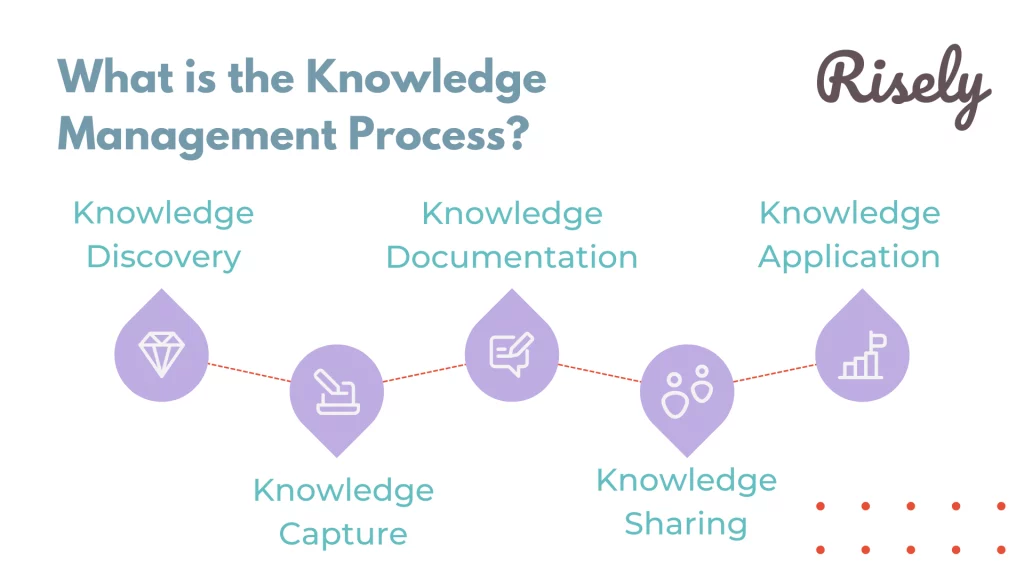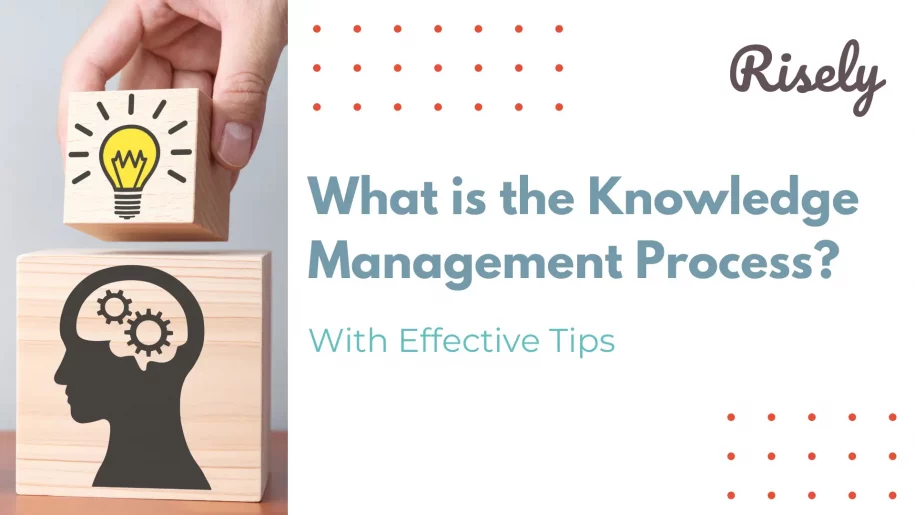What is the Knowledge Management Process? With Effective Tips
In today’s fast-paced world, the knowledge management process plays a crucial role in ensuring that organizations can make informed decisions and stay ahead of their competition. It is a systematic approach to capturing, storing, sharing, and utilizing organizational knowledge. In this blog post, we will take a deep dive into the five steps of the knowledge management process and discuss its key components. We will also provide practical tips for implementing a successful knowledge management process in your organization. So whether you are an HR professional looking to streamline your learning and development initiatives or a team leader wanting to improve collaboration amongst team members, this blog post has got you covered!What is the Knowledge Management Process?
To effectively share knowledge within the organization, it is crucial to understand the knowledge management process. A knowledge management system is vital in capturing and organizing valuable information. By implementing an effective knowledge management process, teams can enhance collaboration and productivity. This process involves capturing, documenting, sharing, and applying knowledge to improve decision-making and problem-solving. The benefits of knowledge management can be realized by harnessing the organization’s collective knowledge and promoting a culture of knowledge sharing. Understanding the different types of knowledge and taking the necessary steps to manage it at both the individual and organizational levels is the next step toward success.The Importance of Knowledge Management in L&D and HR Space
Leveraging intellectual capital is crucial in the L&D and HR space. By implementing an effective knowledge management process, organizations can facilitate the sharing best practices and lessons learned among team members. It enhances employee training and development efforts, aligns business processes with organizational goals, and improves efficiency and innovation. Knowledge management enables the organization to tap into its collective knowledge, ensuring that valuable insights are not lost. Organizations can achieve long-term success and thrive in a competitive landscape by taking the necessary steps to manage knowledge effectively.The Role of Team Leaders in the Knowledge Management Process
Team leaders play a crucial role in promoting knowledge sharing among team members. They facilitate the capturing and validating of the team’s collective knowledge, ensuring that it is documented and organized effectively. By encouraging a culture of continuous learning and knowledge discovery, team leaders foster a workforce that is equipped to leverage the organization’s collective knowledge. Effective team leaders also utilize knowledge management tools to support their teams, enabling seamless collaboration and making the necessary steps toward an effective and efficient knowledge management process.Breaking Down the Five Steps of the Knowledge Management Process
We can understand how organizations effectively manage their collective knowledge by breaking down the five steps of the knowledge management process.
Step 1 – Knowledge Discovery: Identifying Valuable Information
The first step in the knowledge management process is knowledge discovery. It involves using analytics and data mining techniques to identify valuable knowledge from various sources. The goal is to capture relevant and actionable knowledge, which can help make informed decisions and improve business operations. By uncovering hidden insights and leveraging the organization’s collective knowledge, knowledge discovery sets the stage for the next necessary steps in the knowledge management process. It provides a big-picture view of the organization’s information landscape and helps in fostering a culture of continuous learning and knowledge sharing.Step 2 – Knowledge Capture: Collecting and Storing Useful Information
Step 2 of the knowledge management process involves the crucial task of knowledge capture. This step focuses on collecting and storing valuable information from various sources. Organizations can streamline the capture process by utilizing automation tools and workflows, ensuring that knowledge is preserved for future use. The captured knowledge creates a comprehensive knowledge base for the entire organization. By capturing different types of knowledge, such as insights from case studies or expertise shared in emails, organizations can harness the benefits of knowledge management in the long run.Step 3 – Knowledge Documentation: Recording Information in Accessible Formats
Recording information in accessible formats is a crucial aspect of the knowledge management process. This step focuses on documenting knowledge in various formats, such as written documents, videos, audio recordings, and more. Organizing and categorizing knowledge enhances its discoverability, allowing for easy retrieval. Adequate documentation facilitates knowledge sharing and transfer within the organization, enabling employees to tap into the organization’s collective knowledge. By documenting knowledge in accessible formats, organizations ensure that the workforce can access and utilize valuable information. It helps enhance knowledge sharing and curtails knowledge hoarding.Step 4 – Knowledge Sharing: Ensuring Access Across Organization
Knowledge sharing is a pivotal aspect of the knowledge management process. It involves disseminating valuable knowledge to stakeholders across the organization. Technology plays a crucial role in facilitating this, with the internet and collaboration tools enabling seamless sharing of information. However, successful knowledge sharing also requires cultural changes and organizational transparency. It fosters an environment where employees can freely share their expertise and insights. Effective knowledge sharing enhances collaboration among teams and improves decision-making processes. It ensures the organization’s collective knowledge is accessible and utilized to its full potential.Step 5 – Knowledge Application: Putting Information to Practical Use
The crucial final step is applying the knowledge captured throughout the knowledge management process. It involves using the knowledge to solve problems, make informed decisions, and drive innovation and process improvement. When the right people have access to the proper knowledge at the right time, it can lead to significant success for the entire organization. Effective knowledge application ensures that the organization’s collective knowledge is leveraged effectively, benefiting the workforce and the organization. In the long run, this step is necessary for the big picture and the continual growth of the organization’s knowledge management process.Other Interesting Reads
Key Components of the Knowledge Management Process Flow
The knowledge management process flow encompasses various vital components. These components include knowledge acquisition, organization, validation, and retrieval. To support this process, organizations rely on knowledge management tools and technologies. Additionally, cultural changes and addressing value gaps are essential considerations in effectively implementing the knowledge management process. It is crucial to align short-term and long-term objectives for sustainable knowledge management. By doing so, organizations can leverage their collective knowledge and reap the benefits of an effective knowledge management process in the long run.Planning: Setting Goals and Objectives
Setting clear goals and objectives is crucial in effective knowledge management. By defining these goals, organizations can identify and prioritize key focus areas based on their specific business needs. Developing a roadmap that outlines the necessary steps and timelines for implementation helps ensure a structured approach. Involving stakeholders from different departments fosters alignment with overall organizational goals. Regularly reviewing and updating goals and objectives allows adaptation to changing business needs, ultimately leading to a successful knowledge management process.Process: Implementing Effective Strategies
To successfully implement effective strategies for knowledge management, it is essential to establish a process that captures and organizes knowledge from various sources. This process should include implementing a knowledge management system that facilitates sharing and retrieval of information. Defining best practices for managing knowledge and standard operating procedures for knowledge creation and documentation ensures effective management. Additionally, leveraging knowledge discovery analytics can help identify valuable knowledge within the organization. Continuous improvement and refinement of the knowledge management process based on feedback and performance metrics are necessary for long-term success.Technology: Leveraging Tools for Knowledge Management
Exploring the wide range of knowledge management tools and technologies available in the market is the first step towards enhancing an organization’s knowledge management process. By assessing the organization’s technology needs, one can select the most suitable tools that align with the goals and objectives of the knowledge management team. Leveraging artificial intelligence (AI) and automation can streamline the knowledge capture and retrieval processes, making it easier for employees to access and share information seamlessly. It is essential to ensure that the selected tools are user-friendly and provide a smooth knowledge-sharing experience. Regularly evaluating and upgrading the technology infrastructure is necessary to keep up with emerging trends and harness the benefits of efficient knowledge management in the long run.People: Key Stakeholders in the Knowledge Management Process
Engaging team members at all levels of the organization in the knowledge management process is crucial. Empowering team leaders to champion knowledge-sharing initiatives within their respective teams can significantly enhance the effectiveness of the process. Fostering a culture of knowledge sharing and collaboration among employees encourages a free flow of information and ideas. Providing training and resources to help individuals acquire and share knowledge effectively is necessary for successful implementation. Recognizing and rewarding employees actively contributing to the knowledge management program ensures continued participation and commitment.Improvement: Continual Enhancements for Optimal Results
Enhancing the knowledge management process to ensure optimal results continually is essential. One way to achieve this is by conducting regular knowledge audits, which involve assessing the organization’s collective knowledge and identifying any gaps that need to be addressed. Another crucial step is continually updating and improving the knowledge organization and classification system. Encouraging employee feedback and suggestions is important, as their insights can significantly enhance the knowledge management process. Additionally, monitoring and measuring the impact of knowledge management initiatives on business operations helps to track progress and make necessary adjustments. Finally, aligning short-term objectives with long-term goals ensures sustainable knowledge management practices in the long run.Effective Tips for Implementing a Successful Knowledge Management Process
Tip 1: Prioritizing Key Information
When implementing an effective knowledge management process, it is essential to prioritize key information. It involves identifying the most critical information and knowledge that needs to be captured and shared within the organization. It is also vital to focus on capturing tacit knowledge, which is often difficult to document or transfer. Prioritizing information directly affecting business outcomes, customer satisfaction, or operational efficiency ensures that resources and time are allocated accordingly. Regularly reviewing and updating the priority list helps to reflect changing business needs and provides the successful capture and sharing of crucial information.Tip 2: Promoting a Culture of Knowledge Sharing
To promote a culture of knowledge sharing within an organization, fostering an environment of trust and collaboration is essential. Employees should feel comfortable sharing their knowledge and ideas without fear of judgment or criticism. Open communication channels and platforms should be encouraged to facilitate the exchange of insights and information. Recognizing and rewarding individuals actively contributing to knowledge-sharing initiatives can further incentivize participation. Providing training and support for effective knowledge-sharing techniques is also essential. Leading by example and demonstrating the value of knowledge sharing through transparent and inclusive practices can inspire others to do the same.Conclusion
In conclusion, implementing a knowledge management process is essential for improving efficiency, productivity, and decision-making. By following the five steps of discovery, capture, documentation, sharing, and application, you can effectively manage and utilize valuable information within your organization. Additionally, it is crucial to focus on critical components such as planning, process, technology, people, and improvement to ensure a successful knowledge management process flow. By prioritizing key information and promoting a culture of knowledge sharing, you can create a collaborative environment that fosters innovation and growth. Start implementing these effective tips today to maximize your organization’s knowledge management benefits.Effective planning is the secret to great knowledge management.
Sharpen your goal-setting skills with a free assessment to start winning now.
Other Related Blogs
5 Knowledge Management Metrics L&D Leaders Need to Keep an Eye On
5 Knowledge Management Metrics L&D Leaders Need to Keep an Eye On As a Learning and Development leader, you understand the importance of knowledge management for your organization. But how…
How To Manage Interns? 7 Tips For Great Results
How To Manage Interns? 7 Tips For Great Results With the concept of internships being in full swing, managers need to know how interns can benefit their teams. By understanding…
5 Top Examples of Knowledge Management Systems for 2023
5 Top Examples of Knowledge Management Systems for 2023 Knowledge Management Systems (KMS) are becoming increasingly popular as businesses realize the importance of organizing and sharing knowledge to improve efficiency.…
6-step template to make Reverse Brainstorming the Key to Unlocking Innovation
6-step template to make Reverse Brainstorming the Key to Unlocking Innovation As an innovator, you know that brainstorming is a crucial part of the creative process. But have you ever…


